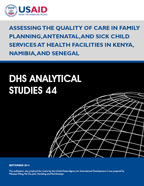- PUBLICATIONS
- JOURNAL ARTICLES
- ACCESS PUBLICATIONS
Publications Summary
- Document Type
- Analytical Studies
- Publication Topic(s)
- Child Health and Development, Family Planning, Maternal Health
- Country(s)
- Kenya, Namibia, Senegal
- Language
- English
- Recommended Citation
- Wang, Wenjuan, Mai Do, John Hembling, and Paul Ametepi. 2014. Assessing the Quality of Care in Family Planning, Antenatal, and Sick Child Services at Health Facilities in Kenya, Namibia, and Senegal. DHS Analytical Studies No. 44. Rockville, Maryland, USA: ICF International.
- Download Citation
- RIS format / Text format / Endnote format
- Publication Date
- September 2014
- Publication ID
- AS44
Download
 Assessing the Quality of Care in Family Planning, Antenatal, and Sick Child Services at Health Facilities in Kenya, Namibia, and Senegal (PDF, 808K)
Assessing the Quality of Care in Family Planning, Antenatal, and Sick Child Services at Health Facilities in Kenya, Namibia, and Senegal (PDF, 808K)
